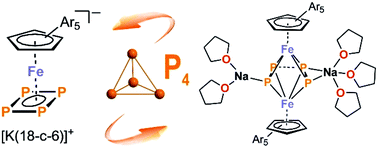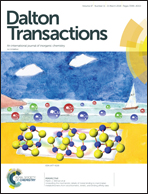Abstract
Reduction of [CpArFe(μ-Br)]2 (1, CpAr = C5(C6H4-4-Et)5) by potassium napthalenide, followed by the addition of white phosphorus, affords [K(18-c-6){CpArFe(η4-P4)}] (2, 18-c-6 = [18]crown-6), which features a planar cyclo-P42− ligand. The related diiron complex [Na2(THF)5(CpArFe)2(μ,η4:4-P4)] (3) was obtained by reducing 1 with sodium amalgam in the presence of P4. Protonation of 3 affords [Na(THF)3][(CpArFe)2(μ,η4:4-P4)(H)] (4), while the reaction of 3 with trimethylchlorosilane gives the nortricyclane compound P7(SiMe3)3 as the main product.

- This article is part of the themed collection: Philip Power at 65: an icon of organometallic chemistry


 Please wait while we load your content...
Please wait while we load your content...